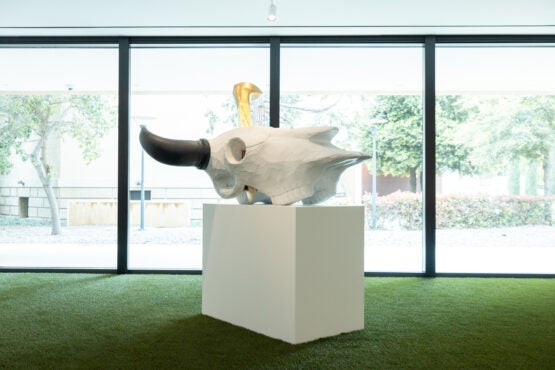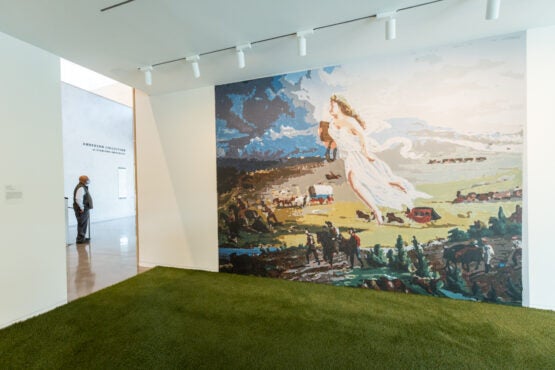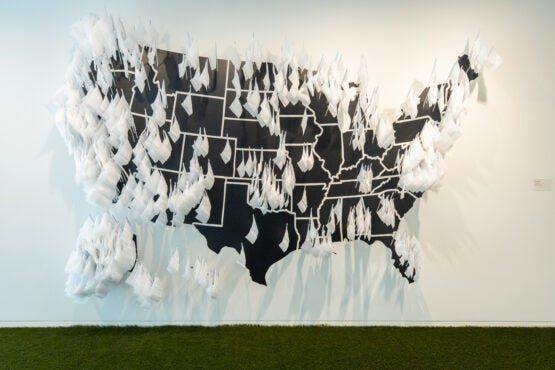Apsáalooke artist Wendy Red Star creatively engages with the Stanford community
In her solo exhibition American Progress at the Anderson Collection, Red Star explores the costly ramifications of westward expansion on Native Americans.
Wendy Red Star: American Progress on view at the Anderson Collection at Stanford University is a solo exhibition of works by the artist Wendy Red Star, who was raised on the Apsáalooke (Crow) reservation in Montana. With historical research, Stanford student collaborations, large-scale installations, and images of sovereignty, Red Star asks viewers to grapple with the layered complexity of American history.

Wendy Red Star, Runs in the Valley, 2022. Hard-coated and painted carved foam. In this sculpture of a buffalo skull, Red Star reimagines the Golden Spike with the inscription “You are without relatives” – a Crow expression used as an insult, suggesting one’s lack of community, family, and people to offer defense and protection. (Image credit: Courtesy of the artist and Sargent’s Daughters Gallery)
On view on the first floor of the museum through Aug. 28, the exhibition is informed by Red Star’s cultural heritage and engagement with many forms of creative expression. She addresses the racism, displacement, and culture surrounding the United States’ westward expansion in the 19th century with works created specifically for the exhibition.
“This collaboration with Wendy Red Star provides us with a very special opportunity to present an expanded view of American art to students and the public by exhibiting new work by an artist whose research-based practice addresses significant issues of our time,” said Jason Linetzky, director of the Anderson Collection, who is always looking for ways to demonstrate the connections between the study, creation, and experience of art.
On April 27, during a three-day campus engagement with students, Red Star will deliver the Anderson Collections’ annual Burt and Deedee McMurtry Lecture, a free public program. She will be in conversation with Karen Biestman, associate dean and director of the Native American Cultural Center and the dean for community engagement and diversity at Stanford. The lecture and conversation will focus on Red Star’s experience as an Apsáalooke artist and her American Progress exhibition.
“We look forward to welcoming the artist to campus to engage with students and the community,” Linetzky said.
Lady Columbia

Wendy Red Star, American Progress, 2022. Wallpaper print based on an original paint-by-numbers painting of John Gast’s American Progress by Stanford students and staff Renad Abualjamal, Emily Beeston, Marco Gonzalez, Audrey Kearns, Jason Linetzky, Crystal Liu, Jean MacDougall, Ximena Martinez, Smiti Mittal, Sarah Panzer, Nik Rost, Aimee Shapiro, Mark Shunney, Ileana Tejada, and Mhar Tenorio. (Image credit: Courtesy of the artist and Sargent’s Daughters Gallery)
John Gast’s 1872 painting American Progress is the namesake and cornerstone for the new works at the Anderson Collection, beginning with a cheeky larger-than-life fabric female figure floating above the museum lobby. In Gast’s painting, an illuminated angel-like figure in diaphanous white known as “Lady Columbia” hovers over an American landscape that includes Native Americans being driven west by white pioneers. Her divine appearance, the book, and telegraph line, attributes that she holds in her hands, together with her lofty oversight of the progression below, suggest moral and intellectual authority. In both Gast’s painting and Red Star’s overstuffed caricature figure titled America as a Woman, the floating female appears to be blessing the people below.
Inside the Wisch Family Gallery, a wallpaper print of a paint-by-numbers version of American Progress, done by Stanford students and museum staff following Red Star’s remote instructions, covers one of the gallery walls. The paint-by-numbers version is abstracted and sometimes appears messy and unfinished, which Red Star intended as an echo of the history of the United States. Aimee Shapiro, director of programming and engagement at the Anderson Collection and curator of the exhibition, says of the work, “The West was developed through the ideals of capitalism and individualism at the expense of the people, cultures, and wildlife that had long inhabited it. In this image, Lady Columbia effectively chases out what white settlers saw as undesirable, unwanted, and disposable.”
Looking to the future
Other collaborative works in the exhibition include a projected digital slideshow of tribal seals of the United States and a corresponding work titled Their Land, which locates the communities represented by these seals, and current tribal lands, on the map of the United States. Over a dozen Stanford students, including those affiliated with the Center for Comparative Studies in Race and Ethnicity and the Institute for Diversity in the Arts, conducted research and gathered the material in collaboration with the artist for these two works.

Wendy Red Star, Their Land, 2022. Wallpaper print and white hand flags. (Image credit: Courtesy of the artist and Sargent’s Daughters Gallery)
“Red Star not only explores the painful past of westward expansion but also looks to the future using symbols and seals of many of the registered and unregistered Native tribes in the United States, showcasing the sovereignty of Native communities,” said Shapiro. New seals will be added to the digital slideshow as student researchers make discoveries throughout the spring quarter.
Shapiro believes that this collaborative exhibition involving students makes it truly unique. “The connection between a living artist and a student can be life-changing. Through this project, students were able to become artists themselves, whose working process required research as well as the act of art-making to be on view at a contemporary art museum,” Shapiro said.
The anchoring piece of the exhibition, American Progress, and the projected seals of tribes from across our country “make visible the commitment of both the students and the artist to present a counter-narrative to the much more common displays of American history in museums,” she added.
Also on view are lithographs that present Red Star’s genealogy and sculptural and painted depictions of buffalo, which were sustenance for Native people and a target for elimination by the settlers during the westward expansion.
To register for the McMurtry Lecture featuring Red Star, which will include a Q&A with the artist, click here.
